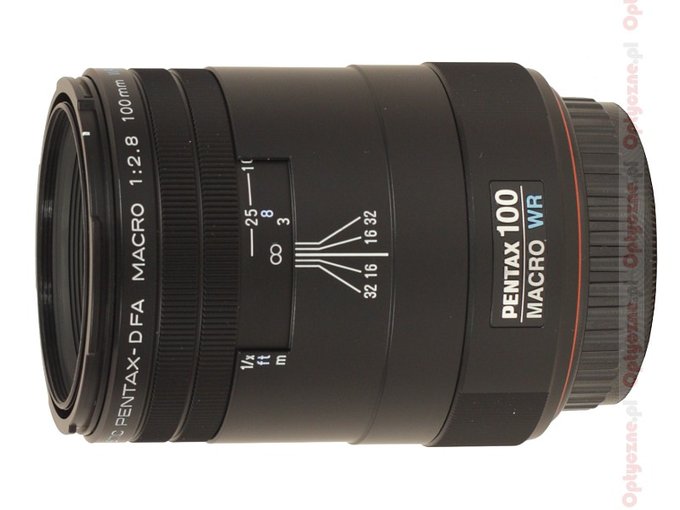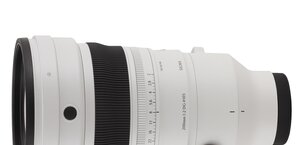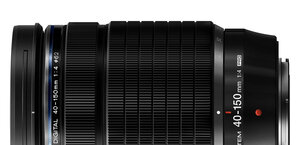Pentax smc D FA 100 mm f/2.8 Macro WR
1. Introduction
Pentax doesn't have a good luck when it comes to lens tests on our website - for several reasons. One of the most important reasons was worse availability of Pentax’s optics on the Polish market. The situation has been changing lately, mainly because of the Fotozakupy.pl shop which has been enlarging its offer by products of this range. The shop wants to have more and more Pentax lenses in stock so they can be readily available for potential buyers and also for us, the testers.
The second important reason is the right choice of a body for the tests. At the beginning of our activity, the tests, published on the Optyczne.pl, were based on such bodies as the Canon EOS 20D, the Nikon D200, the Pentax K10D and the Sony A100. The Canon featured the lowest pixel density and gave the lowest MTFs. We hoped that all bodies using a 10 Mpix CCD sensor would give exactly the same resolution results. Only the D200 and A100 measured up to our expectations. Unfortunately the K10D showed clear differences in MTFs, measured on vertical and horizontal borders, creating serious problems for example in astigmatism tests and making direct comparisons with other systems rather difficult. Small wonder we were rather reluctant to use the K10D in our test very often.
Please Support UsIf you enjoy our reviews and articles, and you want us to continue our work please, support our website by donating through PayPal. The funds are going to be used for paying our editorial team, renting servers, and equipping our testing studio; only that way we will be able to continue providing you interesting content for free. |
- - - - - - - - - - - - - - - - - - - - - - - - - - - - - - - - - - - - - - - - - - - - - - - -
After the launch of the K20D the situation improved a bit - the differences between coordinates disappeared. The problem was that the MTFs, generated by the 14 Mpix sensor of the K20D, didn’t differ much from the results we got on the K10D. It wasn’t good news at all. We knew that the never-ending megapixels race would make us to progress to more densely pixel-packed sensors. The K20D generated relatively low MTFs and, although they allowed us to test optics without any problems, they didn’t make the direct comparison of results with other systems easier, as those systems boasted sensors of 14-18 Mpix. The lack of initial mirror lock-up with the times longer than 3 seconds didn’t encourage testing longer lenses either.
The first change in tests of smaller sensors’ optics was parting with the elderly 20D and substituting it with the 15-Mpix 50D. Once again we dealt with a different pixel density and different MTF values. Fortunately the level was not exactly new because the 50D’s linear pixel density is in the area of 1% the same as that of the Olympus E-3, used in the 4/3 optics tests. Both cameras give very similar MTFs and their results are quite easy to compare.
The launching of the 16 Mpix CMOS Sony sensor was really a piece of good news. Its pixel density is only by 1% lower than the linear density of the E-3 and only 2% lower than that of the 50D. It means that using the 50D, the E-3 and other 16 Mpix sensor bodies with the 1.5x multiple you have an opportunity to get practically the same MTFs results in the case of five different systems. We haven’t had a similar occasion since the very start of the Optyczne.pl
Linear densities of pixels are not all, that’s why we waited for the first tests with some apprehension. Anticipating a bit the content of the Pentax K-5 test we can say that this model proved to be fully in line with our expectations. The sensor is programmed in such a way that RAW files are not sharpened, they don’t show differences in resolution between vertical and horizontal borders and all programmed corrections can be removed; it also provides a fully-fledged mirror lock-up function. As a result the K-5 gives exactly the same MTFs as the Canon 50D. The graph below shows it very clearly – we compared the results of the Canon EOS 50D plus EF 100 mm f/2.8L IS USM tandem with those of the Pentax K-5 plus the smc D FA 100 mm f/2.8 Macro WR lens. As macro 100 mm lenses are often the sharpest devices in a given system, they are perfect to show peak achievements of any detector.
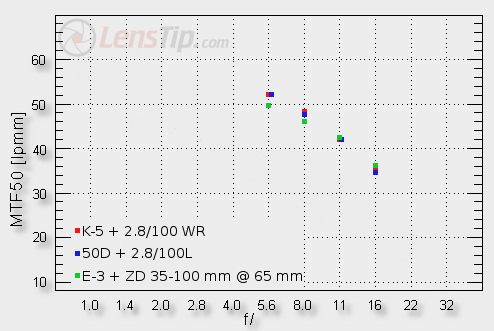
From our point of view it would be difficult to get anything better. The values, the K-5 and the 50D show here, are identical to such a degree that for two out of four presented apertures the results were the same within an accuracy of 0.1 lpmm. Taking into account the fact that measurement errors on this level amount to 0.5 lpmm the accuracy is perfect indeed. It means any direct comparisons between the optics of Pentax and that of Canon and Olympus can now be performed without any problems. We also hope to get similar results for the Nikon D7000 (perhaps the successor of the D300s). and an advanced Sony body.
The values, presented for the Olympus are a bit lower - this is the effect of lack of a macro lens with focal lengths being the equivalent of 150-160 mm in this system; we had to take the ZD 35-100 mm lens for comparison, a splendid zoom device but still a tad worse than a perfect “prime”. Nonetheless the sharpest Olympus lenses can also exceed the level of 50 lpmm – exactly like instruments tested on the 50D and the K-5.
After such a lengthy introduction we would like to invite you to read our first test performed on the Pentax K-5. This body is going to be a part of our editorial office equipment so the number of tested Pentax devices should increase significantly.
As we mentioned earlier, the lens was provided for our tests by Fotozakupy.pl.
You are also invited to get acquainted with our test procedure, described in the article "How do we test lenses?" If you feel it’s still not enough, please go to our FAQ section where you can find some further explanation.
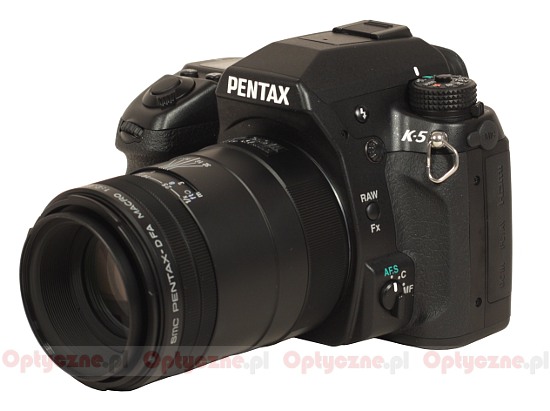 |




